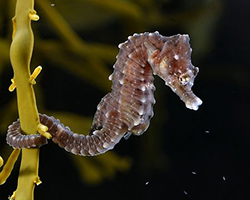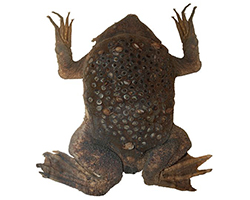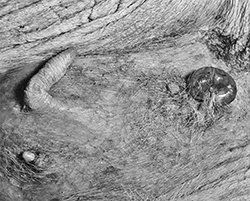Where Does Development Happen?

For sexually reproducing animals, the moment that sperm and egg meet is just the first step of the journey to creating a new being. Next, the embryo must develop all the important organs necessary for life. There are many places an embryo can develop. Some animals develop in an egg and hatch out – this is called ‘oviparous’ development. Other animals have ‘viviparous’ development. For them, the young develop nearly fully inside the parent’s body. Some animals even blur the lines between oviparous and viviparous. Here are just a few examples of different places animals develop.
Womb: Puppies, kittens, humans, and other mammals spend a lot of time developing in the protection of the inside of their mother’s body. Instead of providing nutrients in an egg, the female’s body transfers food to the embryo through the blood using a structure called a placenta.

Brood pouch: In seahorses, male and female roles are reversed. The female lays eggs into a special brood pouch in the male’s body. The eggs attach to the walls of the brood pouch. The soft walls provide nutrients and oxygen to the eggs for many weeks of development.
Open water: In most fish and frogs, eggs are laid and fertilized outside the body, in the water. When oviparous animals lay eggs in water, the outside of the egg can be very thin, as the eggs don’t need much protection from a dry environment. Sometimes the parent just leaves the eggs, other times it protects it. Some octopus moms protect their eggs until they hatch. Mom may guard them night and day, never leaving, even to eat.

Mother’s back: Most toad eggs are left to develop in the water. But, the Pipa pipa toad doesn’t like to take any chances. When the toads mate, they hold each other and do backflips. As they are turning, the female lays eggs and the male releases sperm. The motion causes the eggs to end up on the female’s back. The babies develop inside the protection of her back skin, and pop out as they hatch.
Eggs with armor: When eggs are laid on land, what do you think needs to be different? The egg needs a bit more protection, whether it is from a hard eggshell, a thicker egg membrane, or a surrounding mucus sack. Shells are made of a thin firm layer that protects the embryo from dust and microbes. The shell helps keep the embryo from drying out too much, but is still porous enough to let air and some moisture pass through. Eggs are usually laid in protected nests. Sometimes the mother will sit on them to keep them warm or to help them save water. Warmth and water are both important for development.

Womb and pouch: Marsupials are animals that have pouches, like kangaroos, koalas, and opossums. In these animals, the embryo first grows inside the female’s body in a womb, like other mammals. When the baby is barely bigger than a jellybean, it crawls out of the uterus, up the mother’s body, and into a pouch made out of a flap of skin. In the pouch, it’s warm and safe, and there is a lot of milk to drink. The baby marsupial doesn’t leave the pouch until it’s much bigger.
Egg inside the mother: Some fish, reptiles, amphibians, and non-bony fish (like sharks) use a strategy that is sort of in between oviparous and viviparous. Embryos develop in eggs that hatch inside the animal. The offspring then go through “live birth,” where they are born after already emerging from the egg. This is called ovoviviparity. In these animals, the egg provides all the nutrients the embryo needs, just like in animals with external development. However, the eggs are held within the mother’s body to help keep them safe.
Additional images via Wikimedia Commons. Port Jackson shark egg image by Ian Armstrong.
Read more about: To Breed or Not to Breed
Bibliographic details:
- Article: Where Does Development Happen?
- Author(s): Dr. Biology
- Publisher: Arizona State University School of Life Sciences Ask A Biologist
- Site name: ASU - Ask A Biologist
- Date published:
- Date accessed:
- Link: https://askabiologist.asu.edu/where-to-develop
APA Style
Dr. Biology. (). Where Does Development Happen?. ASU - Ask A Biologist. Retrieved from https://askabiologist.asu.edu/where-to-develop
Chicago Manual of Style
Dr. Biology. "Where Does Development Happen?". ASU - Ask A Biologist. . https://askabiologist.asu.edu/where-to-develop
Dr. Biology. "Where Does Development Happen?". ASU - Ask A Biologist. . ASU - Ask A Biologist, Web. https://askabiologist.asu.edu/where-to-develop
MLA 2017 Style

Be Part of
Ask A Biologist
By volunteering, or simply sending us feedback on the site. Scientists, teachers, writers, illustrators, and translators are all important to the program. If you are interested in helping with the website we have a Volunteers page to get the process started.

